University Healthcare Module: Focused Assessment Procedures Review
VerifiedAdded on 2022/07/28
|7
|1168
|33
Practical Assignment
AI Summary
This assignment provides a detailed guide to performing a focused healthcare assessment. It begins with the importance of patient preparation, including positioning, privacy, and comfortable clothing. The assessment then progresses to vital signs (heart rate, respiratory rate, blood pressure, and oxygen saturation) and requests for additional tests like ECG and blood tests. The document outlines the assessment of various body systems including the thorax (symmetry, PMI, skin color), eyes (Xanthelasma, Arcus Senilis), palpation (skin texture, edema, breathing, arteries, veins), and clubbing of fingers and toes. It provides instructions on percussion and auscultation techniques, including heart sounds and the assessment of angina, detailing the nature, location, intensity, and relieving/aggravating factors of the pain. The document stresses the importance of accurately recording and interpreting findings to aid in diagnosis and treatment.
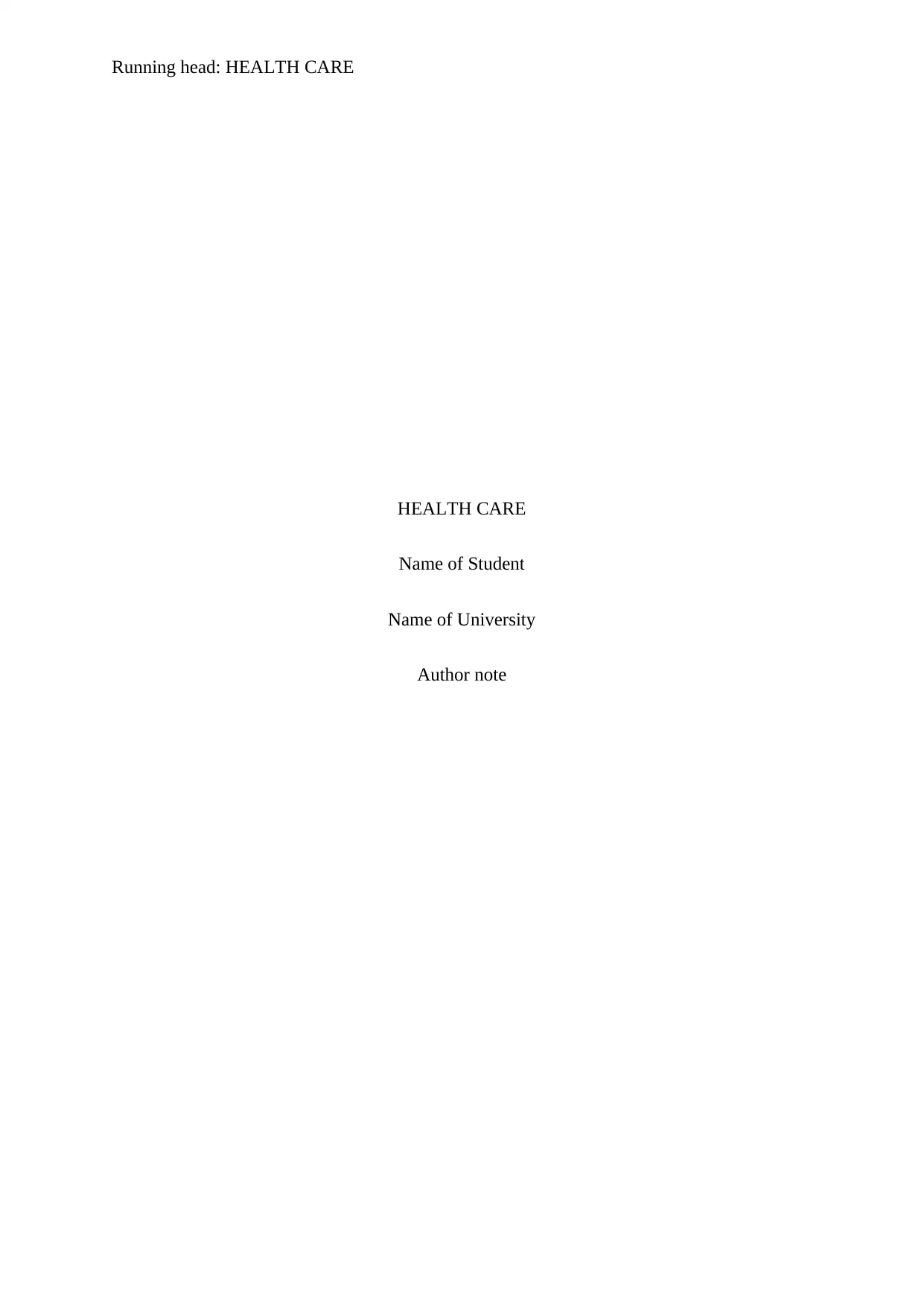
Running head: HEALTH CARE
HEALTH CARE
Name of Student
Name of University
Author note
HEALTH CARE
Name of Student
Name of University
Author note
Paraphrase This Document
Need a fresh take? Get an instant paraphrase of this document with our AI Paraphraser
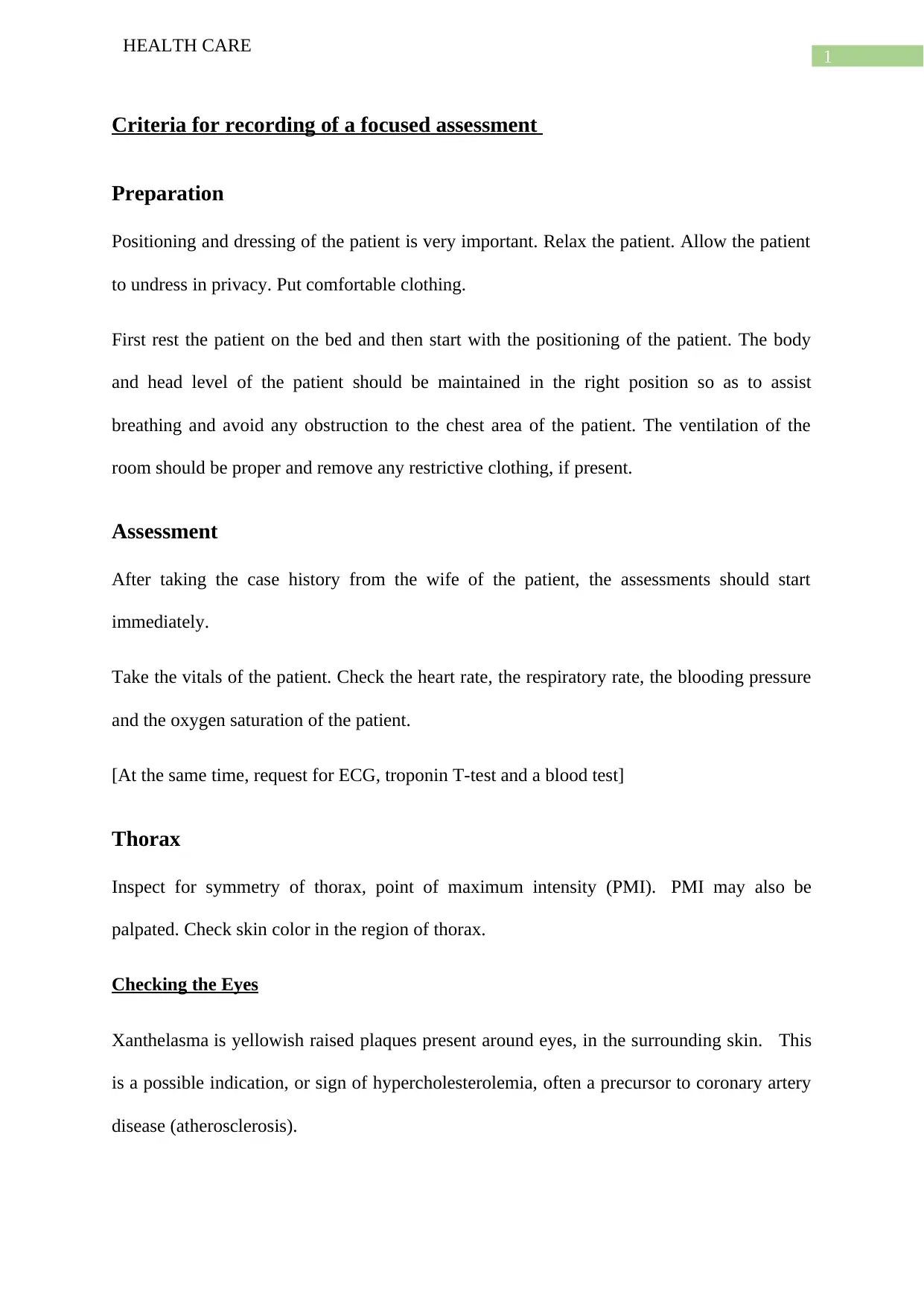
1
HEALTH CARE
Criteria for recording of a focused assessment
Preparation
Positioning and dressing of the patient is very important. Relax the patient. Allow the patient
to undress in privacy. Put comfortable clothing.
First rest the patient on the bed and then start with the positioning of the patient. The body
and head level of the patient should be maintained in the right position so as to assist
breathing and avoid any obstruction to the chest area of the patient. The ventilation of the
room should be proper and remove any restrictive clothing, if present.
Assessment
After taking the case history from the wife of the patient, the assessments should start
immediately.
Take the vitals of the patient. Check the heart rate, the respiratory rate, the blooding pressure
and the oxygen saturation of the patient.
[At the same time, request for ECG, troponin T-test and a blood test]
Thorax
Inspect for symmetry of thorax, point of maximum intensity (PMI). PMI may also be
palpated. Check skin color in the region of thorax.
Checking the Eyes
Xanthelasma is yellowish raised plaques present around eyes, in the surrounding skin. This
is a possible indication, or sign of hypercholesterolemia, often a precursor to coronary artery
disease (atherosclerosis).
HEALTH CARE
Criteria for recording of a focused assessment
Preparation
Positioning and dressing of the patient is very important. Relax the patient. Allow the patient
to undress in privacy. Put comfortable clothing.
First rest the patient on the bed and then start with the positioning of the patient. The body
and head level of the patient should be maintained in the right position so as to assist
breathing and avoid any obstruction to the chest area of the patient. The ventilation of the
room should be proper and remove any restrictive clothing, if present.
Assessment
After taking the case history from the wife of the patient, the assessments should start
immediately.
Take the vitals of the patient. Check the heart rate, the respiratory rate, the blooding pressure
and the oxygen saturation of the patient.
[At the same time, request for ECG, troponin T-test and a blood test]
Thorax
Inspect for symmetry of thorax, point of maximum intensity (PMI). PMI may also be
palpated. Check skin color in the region of thorax.
Checking the Eyes
Xanthelasma is yellowish raised plaques present around eyes, in the surrounding skin. This
is a possible indication, or sign of hypercholesterolemia, often a precursor to coronary artery
disease (atherosclerosis).
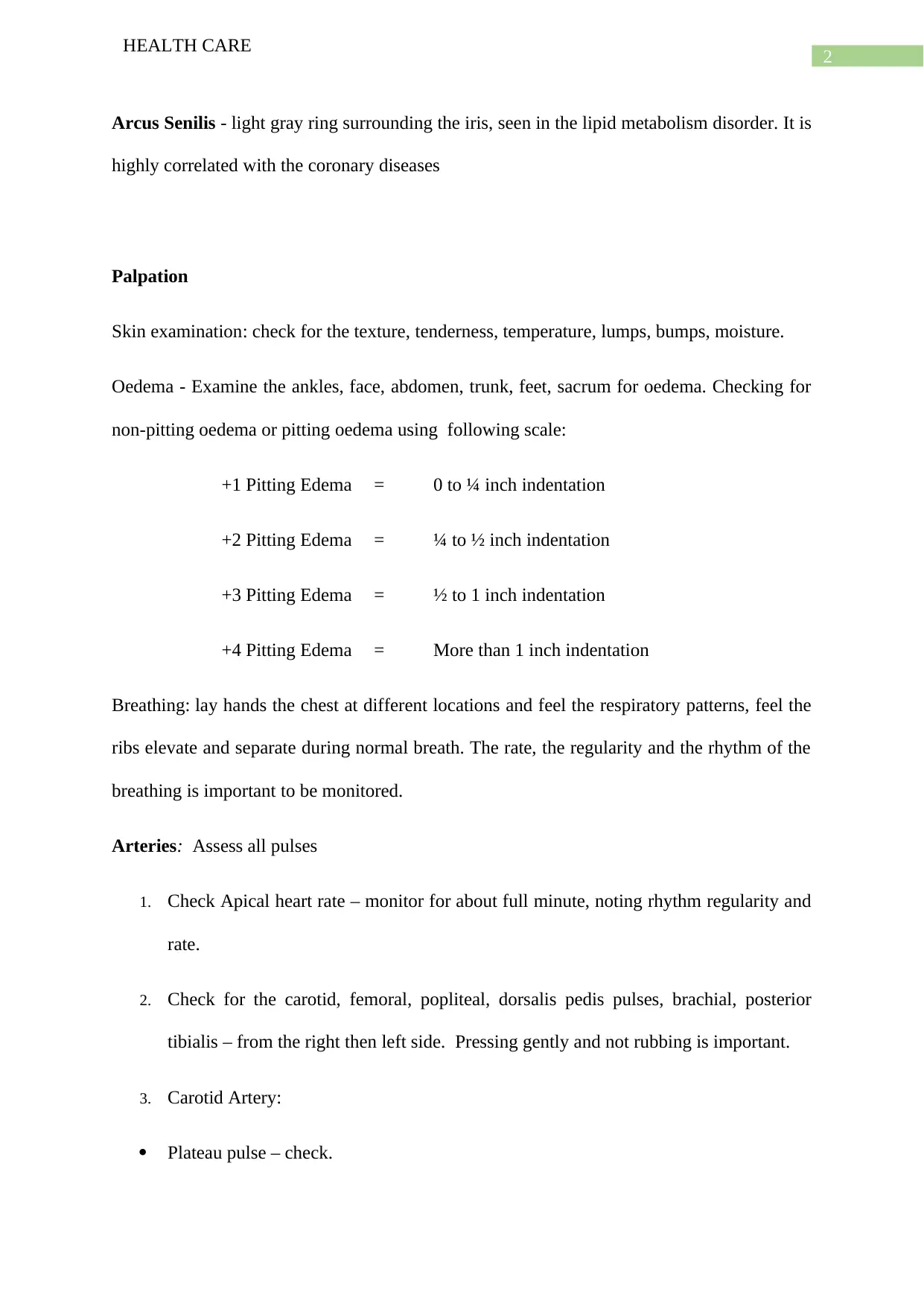
2
HEALTH CARE
Arcus Senilis - light gray ring surrounding the iris, seen in the lipid metabolism disorder. It is
highly correlated with the coronary diseases
Palpation
Skin examination: check for the texture, tenderness, temperature, lumps, bumps, moisture.
Oedema - Examine the ankles, face, abdomen, trunk, feet, sacrum for oedema. Checking for
non-pitting oedema or pitting oedema using following scale:
+1 Pitting Edema = 0 to ¼ inch indentation
+2 Pitting Edema = ¼ to ½ inch indentation
+3 Pitting Edema = ½ to 1 inch indentation
+4 Pitting Edema = More than 1 inch indentation
Breathing: lay hands the chest at different locations and feel the respiratory patterns, feel the
ribs elevate and separate during normal breath. The rate, the regularity and the rhythm of the
breathing is important to be monitored.
Arteries: Assess all pulses
1. Check Apical heart rate – monitor for about full minute, noting rhythm regularity and
rate.
2. Check for the carotid, femoral, popliteal, dorsalis pedis pulses, brachial, posterior
tibialis – from the right then left side. Pressing gently and not rubbing is important.
3. Carotid Artery:
Plateau pulse – check.
HEALTH CARE
Arcus Senilis - light gray ring surrounding the iris, seen in the lipid metabolism disorder. It is
highly correlated with the coronary diseases
Palpation
Skin examination: check for the texture, tenderness, temperature, lumps, bumps, moisture.
Oedema - Examine the ankles, face, abdomen, trunk, feet, sacrum for oedema. Checking for
non-pitting oedema or pitting oedema using following scale:
+1 Pitting Edema = 0 to ¼ inch indentation
+2 Pitting Edema = ¼ to ½ inch indentation
+3 Pitting Edema = ½ to 1 inch indentation
+4 Pitting Edema = More than 1 inch indentation
Breathing: lay hands the chest at different locations and feel the respiratory patterns, feel the
ribs elevate and separate during normal breath. The rate, the regularity and the rhythm of the
breathing is important to be monitored.
Arteries: Assess all pulses
1. Check Apical heart rate – monitor for about full minute, noting rhythm regularity and
rate.
2. Check for the carotid, femoral, popliteal, dorsalis pedis pulses, brachial, posterior
tibialis – from the right then left side. Pressing gently and not rubbing is important.
3. Carotid Artery:
Plateau pulse – check.
⊘ This is a preview!⊘
Do you want full access?
Subscribe today to unlock all pages.

Trusted by 1+ million students worldwide
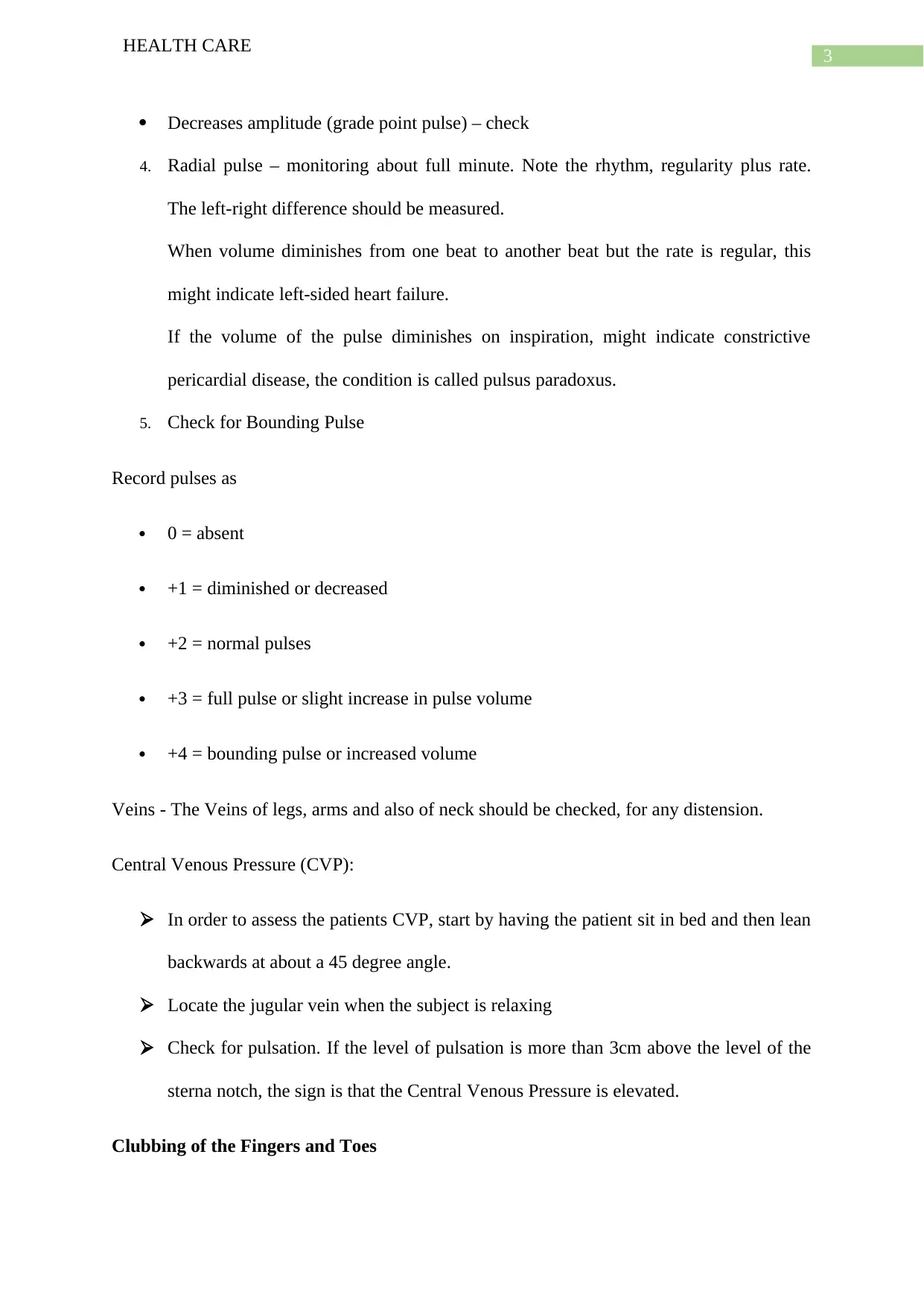
3
HEALTH CARE
Decreases amplitude (grade point pulse) – check
4. Radial pulse – monitoring about full minute. Note the rhythm, regularity plus rate.
The left-right difference should be measured.
When volume diminishes from one beat to another beat but the rate is regular, this
might indicate left-sided heart failure.
If the volume of the pulse diminishes on inspiration, might indicate constrictive
pericardial disease, the condition is called pulsus paradoxus.
5. Check for Bounding Pulse
Record pulses as
0 = absent
+1 = diminished or decreased
+2 = normal pulses
+3 = full pulse or slight increase in pulse volume
+4 = bounding pulse or increased volume
Veins - The Veins of legs, arms and also of neck should be checked, for any distension.
Central Venous Pressure (CVP):
In order to assess the patients CVP, start by having the patient sit in bed and then lean
backwards at about a 45 degree angle.
Locate the jugular vein when the subject is relaxing
Check for pulsation. If the level of pulsation is more than 3cm above the level of the
sterna notch, the sign is that the Central Venous Pressure is elevated.
Clubbing of the Fingers and Toes
HEALTH CARE
Decreases amplitude (grade point pulse) – check
4. Radial pulse – monitoring about full minute. Note the rhythm, regularity plus rate.
The left-right difference should be measured.
When volume diminishes from one beat to another beat but the rate is regular, this
might indicate left-sided heart failure.
If the volume of the pulse diminishes on inspiration, might indicate constrictive
pericardial disease, the condition is called pulsus paradoxus.
5. Check for Bounding Pulse
Record pulses as
0 = absent
+1 = diminished or decreased
+2 = normal pulses
+3 = full pulse or slight increase in pulse volume
+4 = bounding pulse or increased volume
Veins - The Veins of legs, arms and also of neck should be checked, for any distension.
Central Venous Pressure (CVP):
In order to assess the patients CVP, start by having the patient sit in bed and then lean
backwards at about a 45 degree angle.
Locate the jugular vein when the subject is relaxing
Check for pulsation. If the level of pulsation is more than 3cm above the level of the
sterna notch, the sign is that the Central Venous Pressure is elevated.
Clubbing of the Fingers and Toes
Paraphrase This Document
Need a fresh take? Get an instant paraphrase of this document with our AI Paraphraser
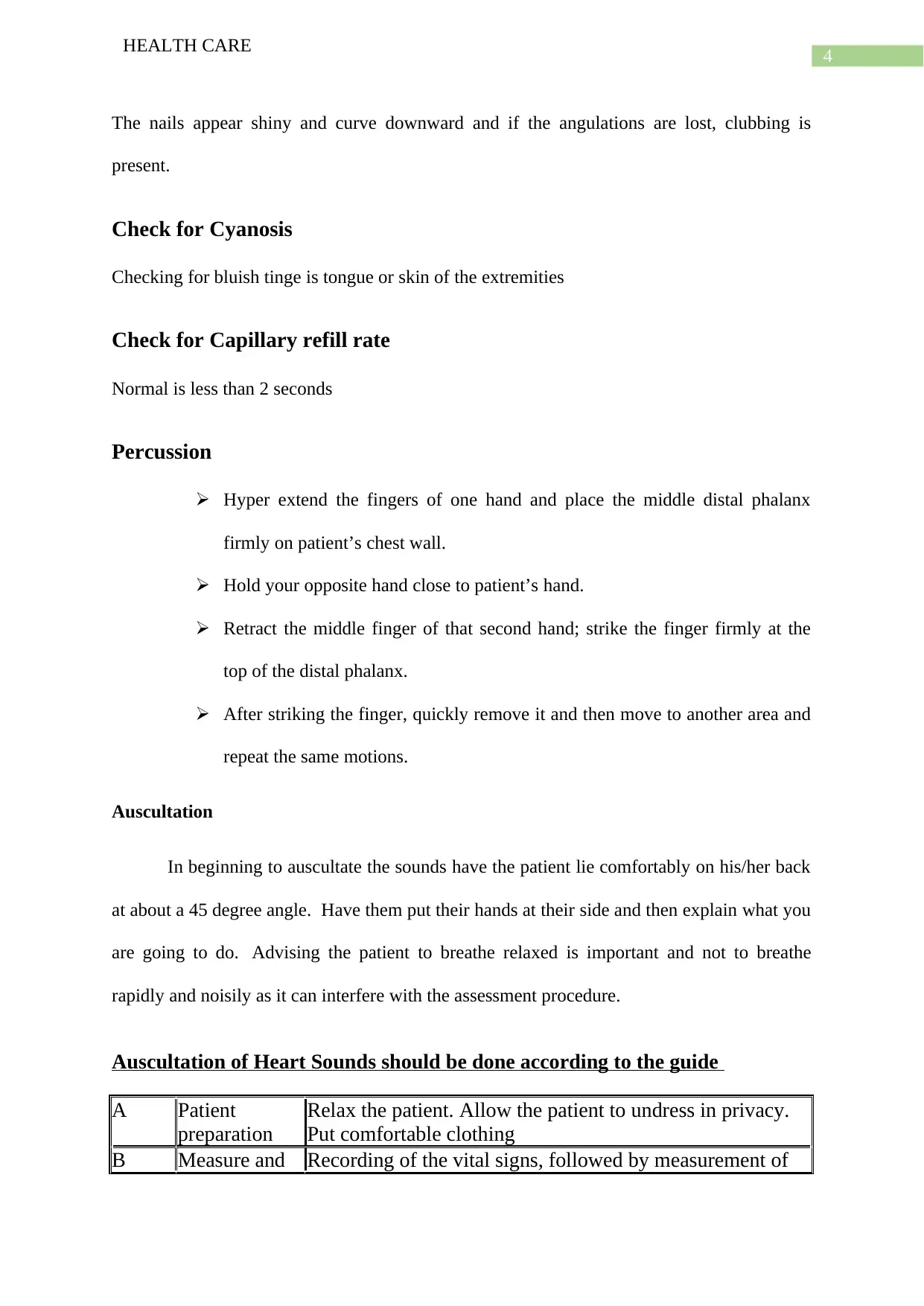
4
HEALTH CARE
The nails appear shiny and curve downward and if the angulations are lost, clubbing is
present.
Check for Cyanosis
Checking for bluish tinge is tongue or skin of the extremities
Check for Capillary refill rate
Normal is less than 2 seconds
Percussion
Hyper extend the fingers of one hand and place the middle distal phalanx
firmly on patient’s chest wall.
Hold your opposite hand close to patient’s hand.
Retract the middle finger of that second hand; strike the finger firmly at the
top of the distal phalanx.
After striking the finger, quickly remove it and then move to another area and
repeat the same motions.
Auscultation
In beginning to auscultate the sounds have the patient lie comfortably on his/her back
at about a 45 degree angle. Have them put their hands at their side and then explain what you
are going to do. Advising the patient to breathe relaxed is important and not to breathe
rapidly and noisily as it can interfere with the assessment procedure.
Auscultation of Heart Sounds should be done according to the guide
A Patient
preparation
Relax the patient. Allow the patient to undress in privacy.
Put comfortable clothing
B Measure and Recording of the vital signs, followed by measurement of
HEALTH CARE
The nails appear shiny and curve downward and if the angulations are lost, clubbing is
present.
Check for Cyanosis
Checking for bluish tinge is tongue or skin of the extremities
Check for Capillary refill rate
Normal is less than 2 seconds
Percussion
Hyper extend the fingers of one hand and place the middle distal phalanx
firmly on patient’s chest wall.
Hold your opposite hand close to patient’s hand.
Retract the middle finger of that second hand; strike the finger firmly at the
top of the distal phalanx.
After striking the finger, quickly remove it and then move to another area and
repeat the same motions.
Auscultation
In beginning to auscultate the sounds have the patient lie comfortably on his/her back
at about a 45 degree angle. Have them put their hands at their side and then explain what you
are going to do. Advising the patient to breathe relaxed is important and not to breathe
rapidly and noisily as it can interfere with the assessment procedure.
Auscultation of Heart Sounds should be done according to the guide
A Patient
preparation
Relax the patient. Allow the patient to undress in privacy.
Put comfortable clothing
B Measure and Recording of the vital signs, followed by measurement of
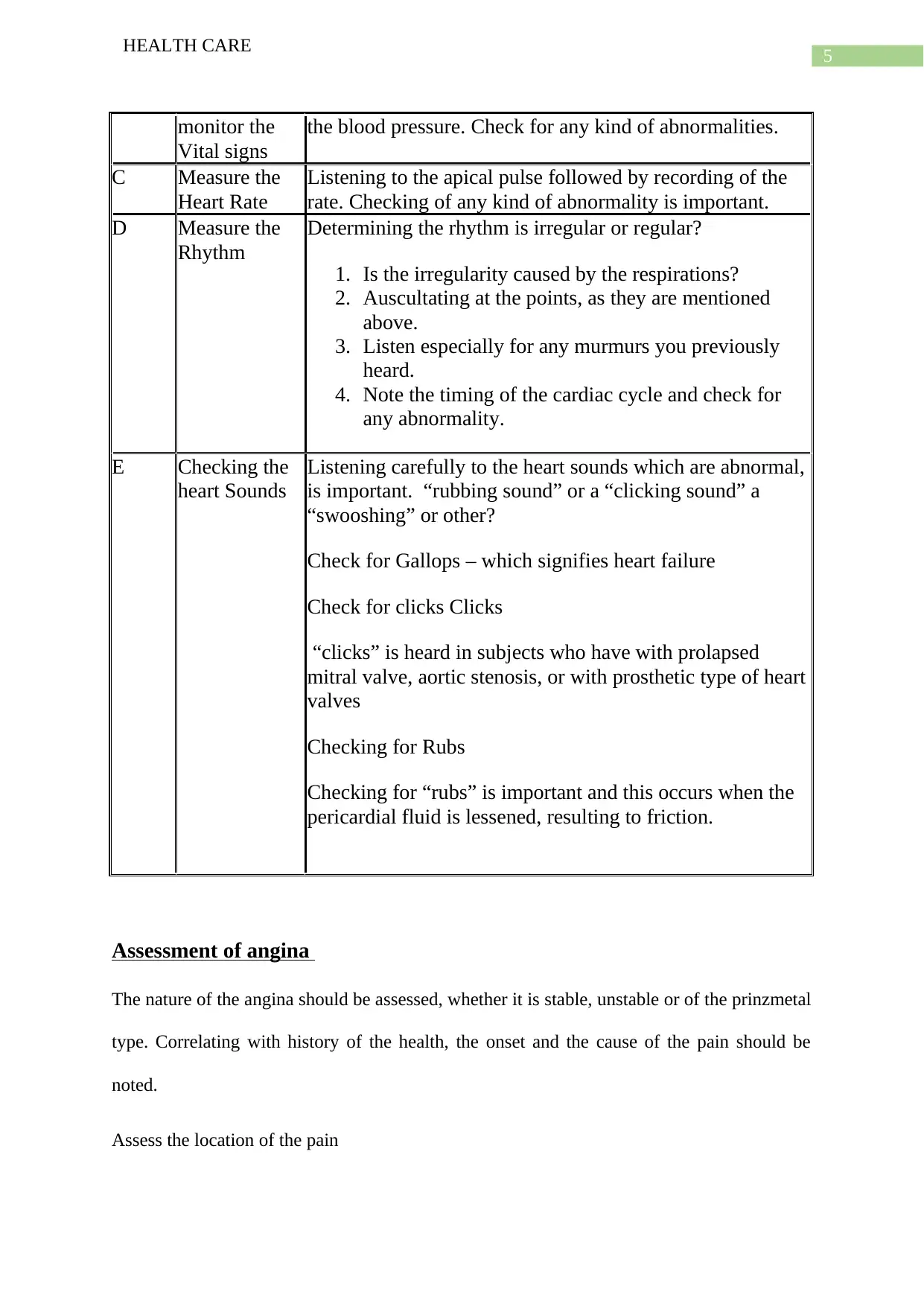
5
HEALTH CARE
monitor the
Vital signs
the blood pressure. Check for any kind of abnormalities.
C Measure the
Heart Rate
Listening to the apical pulse followed by recording of the
rate. Checking of any kind of abnormality is important.
D Measure the
Rhythm
Determining the rhythm is irregular or regular?
1. Is the irregularity caused by the respirations?
2. Auscultating at the points, as they are mentioned
above.
3. Listen especially for any murmurs you previously
heard.
4. Note the timing of the cardiac cycle and check for
any abnormality.
E Checking the
heart Sounds
Listening carefully to the heart sounds which are abnormal,
is important. “rubbing sound” or a “clicking sound” a
“swooshing” or other?
Check for Gallops – which signifies heart failure
Check for clicks Clicks
“clicks” is heard in subjects who have with prolapsed
mitral valve, aortic stenosis, or with prosthetic type of heart
valves
Checking for Rubs
Checking for “rubs” is important and this occurs when the
pericardial fluid is lessened, resulting to friction.
Assessment of angina
The nature of the angina should be assessed, whether it is stable, unstable or of the prinzmetal
type. Correlating with history of the health, the onset and the cause of the pain should be
noted.
Assess the location of the pain
HEALTH CARE
monitor the
Vital signs
the blood pressure. Check for any kind of abnormalities.
C Measure the
Heart Rate
Listening to the apical pulse followed by recording of the
rate. Checking of any kind of abnormality is important.
D Measure the
Rhythm
Determining the rhythm is irregular or regular?
1. Is the irregularity caused by the respirations?
2. Auscultating at the points, as they are mentioned
above.
3. Listen especially for any murmurs you previously
heard.
4. Note the timing of the cardiac cycle and check for
any abnormality.
E Checking the
heart Sounds
Listening carefully to the heart sounds which are abnormal,
is important. “rubbing sound” or a “clicking sound” a
“swooshing” or other?
Check for Gallops – which signifies heart failure
Check for clicks Clicks
“clicks” is heard in subjects who have with prolapsed
mitral valve, aortic stenosis, or with prosthetic type of heart
valves
Checking for Rubs
Checking for “rubs” is important and this occurs when the
pericardial fluid is lessened, resulting to friction.
Assessment of angina
The nature of the angina should be assessed, whether it is stable, unstable or of the prinzmetal
type. Correlating with history of the health, the onset and the cause of the pain should be
noted.
Assess the location of the pain
⊘ This is a preview!⊘
Do you want full access?
Subscribe today to unlock all pages.

Trusted by 1+ million students worldwide
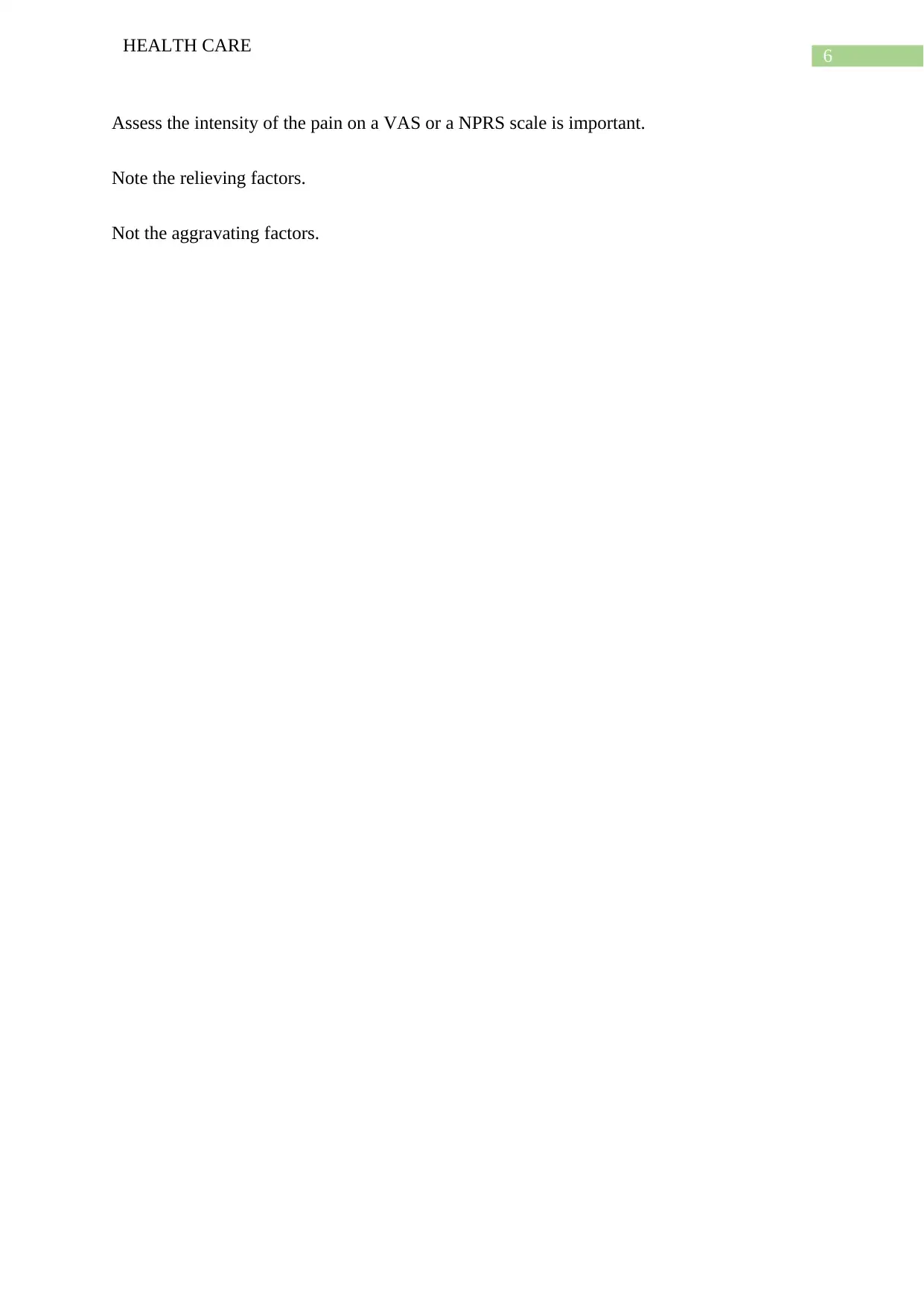
6
HEALTH CARE
Assess the intensity of the pain on a VAS or a NPRS scale is important.
Note the relieving factors.
Not the aggravating factors.
HEALTH CARE
Assess the intensity of the pain on a VAS or a NPRS scale is important.
Note the relieving factors.
Not the aggravating factors.
1 out of 7
Related Documents
Your All-in-One AI-Powered Toolkit for Academic Success.
+13062052269
info@desklib.com
Available 24*7 on WhatsApp / Email
![[object Object]](/_next/static/media/star-bottom.7253800d.svg)
Unlock your academic potential
Copyright © 2020–2025 A2Z Services. All Rights Reserved. Developed and managed by ZUCOL.





